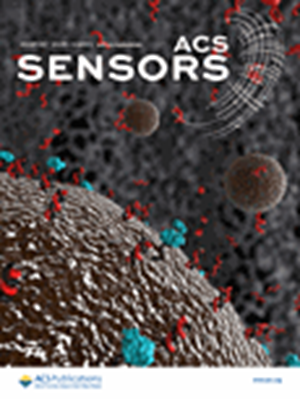整合异质结空位和缺陷水平协同提高H2S化学抗性药物在牙周炎诊断中的性能
IF 9.1
1区 化学
Q1 CHEMISTRY, ANALYTICAL
引用次数: 0
摘要
呼气被认为是样本的重要来源和生物标志物的储存库,特别是对疾病诊断。在这项研究中,我们开发了一种超灵敏的即时护理气体传感器,用于分析硫化氢(H2S),硫化氢是牙周炎的典型生物标志物。将掺铁MoO3-x集成到TiO2纳米管阵列上,开发了一种高性能的金属氧化物半导体(MOS)化学阻式H2S传感器。Fe原子取代MoO3-x不仅会引起氧空位,还会在MoO3-x/TiO2异质结构中产生缺陷水平,从而在室温环境光下协同激活气敏反应。由此产生的气体传感器具有超高灵敏度,快速响应/恢复能力,以及对H2S浓度高达400 ppm的宽范围响应。此外,在70%的相对湿度下,传感装置保持了95%以上的原始响应。该传感器的检测限为十亿分之一(H2S的LOD为0.34 ppb),是迄今为止报道的最敏感的H2S化学电阻器,可用于室温下实时监测健康受试者呼吸中H2S浓度的变化,以及区分牙周炎患者和健康个体的呼吸样本。本研究利用缺陷的协同作用,为开发基于mos的超灵敏H2S传感器诊断牙周炎提供了有效途径。本文章由计算机程序翻译,如有差异,请以英文原文为准。

Integrating Vacancies and Defect Levels in Heterojunctions to Synergistically Enhance the Performance of H2S Chemiresistors for Periodontitis Diagnosis
Exhaled breath is considered an important source of samples and a reservoir of biomarkers, especially for disease diagnosis. In this study, we developed an ultrasensitive point-of-care gas sensor for the analysis of hydrogen sulfide (H2S), which is a typical biomarker for periodontitis. A high-performance metal oxide semiconductor (MOS)-based chemiresistive H2S sensor was developed by integrating Fe-doped MoO3-x onto TiO2 nanotube arrays. The substitution of Fe atoms into MoO3-x not only induced oxygen vacancies, but also generated defect levels in the MoO3-x/TiO2 heterostructure, thus synergistically activating the gas sensing reaction at room temperature under ambient light. The resulting gas sensor exhibited ultrahigh sensitivity, fast response/recovery ability, and wide-range response to H2S concentrations up to 400 ppm. Furthermore, the sensing device maintained more than 95% of its original response at 70% relative humidity. With a subparts-per-billion limit of detection (the LOD for H2S was 0.34 ppb), the present sensor represents the most sensitive H2S chemiresistor reported to date for room-temperature, real-time monitoring of H2S concentration changes in the breath of healthy subjects, as well as for distinguishing breath samples of periodontitis patients and healthy individuals. This study utilizes the synergistic action of defects to provide an effective route for developing MOS-based ultrasensitive H2S sensors for periodontitis diagnosis.
求助全文
通过发布文献求助,成功后即可免费获取论文全文。
去求助
来源期刊

ACS Sensors
Chemical Engineering-Bioengineering
CiteScore
14.50
自引率
3.40%
发文量
372
期刊介绍:
ACS Sensors is a peer-reviewed research journal that focuses on the dissemination of new and original knowledge in the field of sensor science, particularly those that selectively sense chemical or biological species or processes. The journal covers a broad range of topics, including but not limited to biosensors, chemical sensors, gas sensors, intracellular sensors, single molecule sensors, cell chips, and microfluidic devices. It aims to publish articles that address conceptual advances in sensing technology applicable to various types of analytes or application papers that report on the use of existing sensing concepts in new ways or for new analytes.
 求助内容:
求助内容: 应助结果提醒方式:
应助结果提醒方式:


